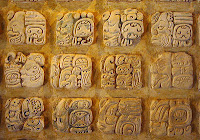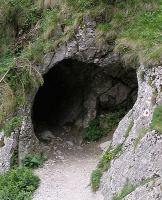 One distinguishing feature between the Nephite and Jaredite cultures seems to have been the form of record keeping. While one engraved stone memorials, the other kept records on metal plates. Thus when we find engraved stone monuments, I believe that we can safely assume that they are evidence of a Jaredite, or neo-jaredite culture.
One distinguishing feature between the Nephite and Jaredite cultures seems to have been the form of record keeping. While one engraved stone memorials, the other kept records on metal plates. Thus when we find engraved stone monuments, I believe that we can safely assume that they are evidence of a Jaredite, or neo-jaredite culture.
Let us begin with the Nephite custom of record keeping. We are told that their official records were engraven on metal plates. The prophet Jacob gives us some insight into their practices. He states:
I cannot write but a little of my words, because of the difficulty of engraving our words upon plates... and we know that the things which we write upon plates must remain; but whatsoever things we write upon anything save it be upon plates must perish and vanish away; but we can write a few words upon plates, which will give our children, and also our beloved brethren, a small degree of knowledge concerning us (Jacob 4:1).
So from Jacob we learn that they 1) wrote their records on plates, and 2) anything that was not written on plates would have decayed or been destroy by the ravages of time; such things as animal skins, bark paper, cloth, etc. This scripture would seem to exclude stone records which could withstand the effects of time. No mention is ever made of the Nephites recording their histories on stone.
The prophet/leader Abinadom further emphazises the fact that all their records were compiled on metal plates. He doesn't allow for any exceptions. We read:
And behold, the record of this people is engraven upon plates which is had by the kings, according to the generations; and I know of no revelation save that which has been written, neither prophecy; wherefore, that which is sufficient is written (Omni 1:11).
 |
| Anthon Transcript |
The Jaredites, on the other hand, apparently were in the habit of using stone monuments to record their royal histories. You will remember that during the reign of the Nephite king Mosiah in Zarahemla a large stone was brought to him. Engraven upon its surface was the history of Coriantumr, the last king of the Jaredites. Mosiah translated this account, probably using the Urim and Thummim. It resulted in an abbreviated version of the Book of Ether. The account states:
 And it came to pass in the days of Mosiah, there was a large stone brought unto him with engravings on it; and he did interpret the engravings by the gift and power of God. And they gave an account of one Coriantumr, and the slain of his people. And Coriantumr was discovered by the people of Zarahemla; and he dwelt with them for the space of nine moons. It also spake a few words concerning his fathers. And his first parents came out from the tower, at the time the Lord confounded the language of the people (Omni 1:30-22).
And it came to pass in the days of Mosiah, there was a large stone brought unto him with engravings on it; and he did interpret the engravings by the gift and power of God. And they gave an account of one Coriantumr, and the slain of his people. And Coriantumr was discovered by the people of Zarahemla; and he dwelt with them for the space of nine moons. It also spake a few words concerning his fathers. And his first parents came out from the tower, at the time the Lord confounded the language of the people (Omni 1:30-22).
Of course, Ether wrote his history of the Jaredites on golden plates, but he seems to have been the exception. All the written records we find in the original Jaredite lands are written in stone; stone stelae, stone altars, stone monuments, stone stairways, and stone statues. Those of the Maya are especially beautiful and elaborate. Many of these are similar to the description of Coriantumr's stone.
 |
| Mayan Glyphs |
Now let us compare the two. On the one hand we have the Nephite metal plates inscribed with characters similar to Egyptian heiratic writing. On the other we have the Jaredite inscribed stones with an image of the ruler accompanied by his royal line, accomplishments, and dates of accendency. These are written in glyphs which are more like oriental writing than they are to any of the Egyptian scripts, and especially to the Reformed Egyptian. They are very different and easily distinguishable from the writing on the Anthon Transcript. Identifying and separating the two should make it easier to locate the individual Nephite and Jaredite lands.
1. Xu, Mike. http://www.chinese.tcu.edu/www_chinese3_tcu_edu.htm (This link is broken, but refer to a later blog at https://moriancumr2.blogspot.com/2019/02/mike-xu-and-jaredite-celts.html)
2. Coe, Michael. The Maya. 1999.
* Jerry Grover has made a study of the Caracters document and attempted to translate it. He study can be found at https://archive.bookofmormoncentral.org/content/translation-%E2%80%9Ccaractors%E2%80%9D-document
* Jerry Grover has made a study of the Caracters document and attempted to translate it. He study can be found at https://archive.bookofmormoncentral.org/content/translation-%E2%80%9Ccaractors%E2%80%9D-document

Where did you get that picture of the modern make of the anthon transcript on that gold sheet? I want one.
ReplyDeleteJay
I can't remember. I think I found it on google images somewhere. I imagine it is from a catalog and would be available for purchase if you can find the supplier.
Delete